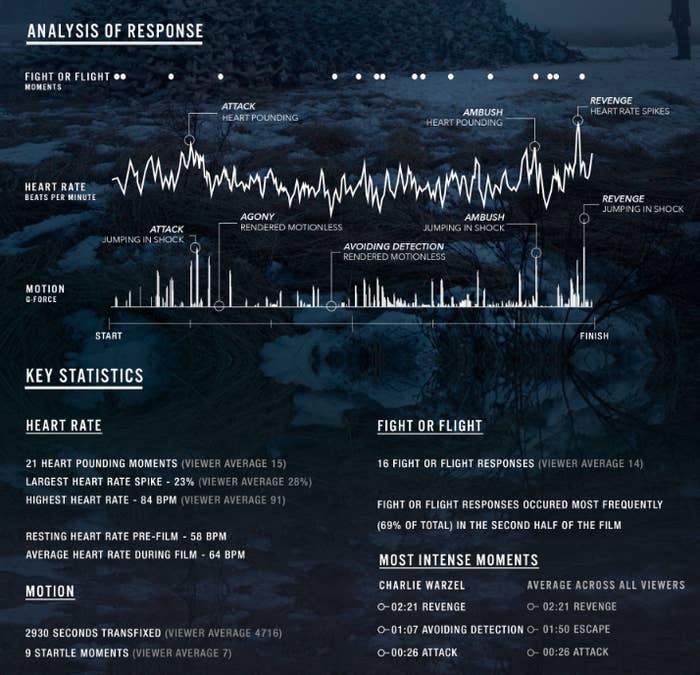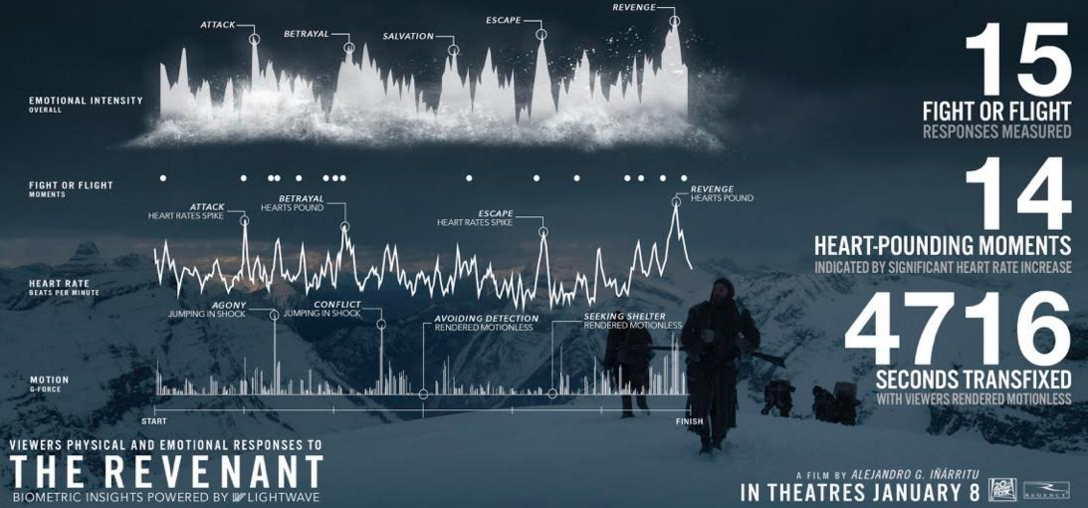
Charlie: My resting heart rate was stable until the bear attack. Then, precisely 26 minutes into Alejandro Iñárritu’s The Revenant, it spiked. As I watched Leonardo DiCaprio being mercilessly mauled by a nightmarish CGI bear, my heart rate began to elevate, slowly at first, before rocketing to above-average levels. During a particularly intense moment near the end of the film — there was a machete! — my heart rate spiked again, beating 23% faster than it did as the lights in the theater dimmed. During the film's two-and-a-half-hour run time, I gaped at the screen, motionless for exactly 2,930 seconds.
Anne: There was a moment, about halfway through the attack, when my entire body shivered. It was precisely 26 minutes into the movie. I usually have to leave the theater to go to the bathroom at least once. But in The Revenant, I not only stayed in my seat the entire time, but spent 4221 seconds — that's 70 minutes — completely transfixed. I startled seven times, and my body went into fight-or-flight mode (what happens to your body when it senses extreme threat) a whopping nineteen times.
We know all this thanks to medical-grade heart rate, motion, temperature, and sound sensors that measured my vitals and those of a colleague 10 times a second for the film’s duration. More specifically, we know these things because Fox Films and a biometrics company called Lightwave strapped some Fitbit-style devices to our wrists to determine what we thought of The Revenant — physiologically. It’s part of an early experimental effort by studios to wring every last intensely nuanced droplet of unfiltered feedback from test audiences. It might also be a glimpse into the future of movie marketing — and moviemaking.
When we arrived at the theater, Lightwave strapped its black rubber tracking bracelets, approximately the size of an Apple Watch, snugly to the wrists of our dominant hands. A green light flickered, indicating that our real-time biometric data was now being fed to a laptop in the back of the theater.
“Pulling data 10 times a second, you can see some amazing, crazy things,” Lightwave CEO Rana June said, securing the band. “We do it through sensor fusion.” That term is a fancy way of saying that Lightwave takes biometric data signals (heart rate, motion, temperature) and merges them with the context of the event (intense scenes, swelling music) to measure physical reactions. One of the “crazy things” we’d be tested for: triggering of the fight-or-flight instinct.
“When your body goes into fight-or-flight mode, there’s a momentary deceleration of the heart rate when something called the orienting response kicks in,” June explained. “The way you get flight-or-flight response is not from a sensor but from a calculation. We have neuroscientists on our team and we’re doing applied neuroscience using wearables data. Engagement could be measured by heart rate increasing while motion is low. Or by a subtle change in the variability between your heartbeats."
According to Lightwave’s data, my body’s fight-or-flight instincts kicked in 16 times during The Revenant. My colleague — who is “stupid-easy to scare” — had 19. All in all, it looks like this:

While Lightwave has tested its software in numerous venues (Wimbledon, the Cannes advertising festival, concerts), none provide the sort of consistent stimulus — the same content, screening to screening — as a movie. The potential benefits for studios and filmmakers are manifold. On the research side, it’s a way to quantify the sorts of things that test screenings have been looking at for decades: engrossment, engagement, pleasure, whether men laugh more than women, whether jokes and plot points resonate with an international audience — now the most crucial market for most American films.
The data — which June assured us was anonymous and only identifiable by gender and Nielsen-esque age ranges — could also be used as a marketing tool: Fox, the studio behind The Revenant, could put “14 Scientifically Proven Heart-Pounding Moments!” or “More than 4,000 seconds of pure transfixion!” in the spot usually reserved for critics' blurbs at the end of a trailer. Or, in the form of a slick, eye-catching, easily-shareable-across-social-media-and-the-internet infographic that uses data captured from 100 audience members in four different U.S. cities:

There’s also the potential for such data to influence the moviemaking process all the way down to the level of the original pitch. The modern blockbuster has always depended on a narrative interspersed by “whammies”: moments in a film (a car chase or fight, a sex scene, horror movie "jumps") that theoretically grip the audience. Jaws, often cited as the first blockbuster, has masterfully placed whammies. In a perfect Hollywood world, every blockbuster would be a lovely integration of plot and whammy. But as the industry grows increasingly reliant on “intellectual property” — concepts, like superheroes, video games, board games, etc., that come with “presold” interest — plot sometimes takes a backseat to spectacle. The flimsier the plot, the greater reliance on whammies: see Transformers 3, Fast & Furious, Step Up, San Andreas -- even Magic Mike XXL.
Today, you can pitch a movie purely on the promise of audience recognition — but as flops like Battleship and Fantastic Four make clear, even that’s not a guarantee of audience interest or engagement. Same with the promise of whammies: Just because it’s an explosion doesn’t mean people will be gripped by it — chalk it up to blockbuster/destruction-of-the-world fatigue. Hollywood has, in recent years, continued to struggle with audience surveys, which no longer seem to predict box office success. But with tech like Lightwave, studios could gain precise information about what sort of sequences, timing, and integration of plot and whammy are most effective for audiences. Basically: an algorithmically tailored, Big Data–fueled paint-by-numbers for a billion-dollar blockbuster.
While Lightwave's tech could serve as a tool that could enhance storytelling in film, it seems equally plausible that it will be used simply to ratchet up those cinematic whammies I mentioned earlier, until the movies we see in theaters are little more than a sizzle reel of explosions and boobs. June, for her part, dismissed these claims. “My hope for this is for people to use the data as they want but not to be led by the data,” she said.
What seems most promising, from an artistic standpoint, is the capacity for Lightwave specifics to sell a film to which audiences might otherwise find themselves indifferent. Perhaps audiences could be convinced to see a film by scientific evidence that it's a great movie experience. And if they were, perhaps studios might be willing to approach the idea of The Blockbuster a bit differently.
A similar tactic worked in the early ’70s, when the studios, floundering in the face of a series of massive bombs and an unpredictable audience, benefited from similar “authenticated” promises of a visceral theater experience, with films like The Exorcist, which the press breathlessly reported to have caused mass fainting, vomiting, and even a miscarriage, and Jaws, which incited screaming, fainting, and a drop in popcorn sales — as clear a marker as any of engagement.

Jaws and Exorcist dominated the box office — and helped establish a new marketing strategy, now established practice, in which studios spent millions on buildup with the understanding that every dollar spent would eventually bring in more. This sort of attention-grabbing publicity was nothing new — horror genre films and exploitation films had been using similar carny-barker-style tactics since the beginning of the cinema. What was new, then, was the scale — and the sophistication.
Lightwave, and the data it generates, offers the next jump in sophistication. At the same time, it points to the increased need to see quantified data of an experience in order to understand how we experienced it. I was engrossed, in other words, because the little chart told me, 24 hours after the fact, that I was — a fact that I could then share, and back up, by posting on social media. It’s no different from the actual Fitbit or any other wearable dedicated to quantifying, and thus ostensibly authenticating, our every movement.
But here’s the thing: Parts of The Revenant were terrifying. It’s arguably the most engrossed either of us has been in the movie theater all year. There were moments of sublime joy and visceral abjection. Anne covered her eyes and winced on two separate occasions. Everything we'd heard before seeing the film proved to be true. But after years of buying into grandiose movie trailers only to be disappointed by the films they promoted, there’s a certain skittishness at play. Now we may actually have supporting scientific evidence to back up movie trailer promises.
It’s inside this rift in the circle of trust between studios and audiences where Lightwave’s technology could prove transformative. Drown out the fears of dead-inside, algorithmic art and the specter of a future filled with vapid, whammy-filled sizzle reels and maybe there’s room for something like hope: that movies could, perhaps, get better. That a technology that, though it might appear to be a gimmick, could have the potential to do something invaluable: help us believe in the blockbuster again.

